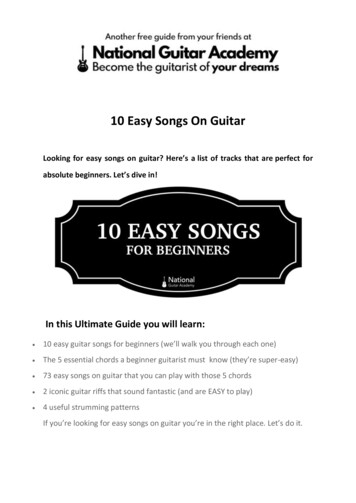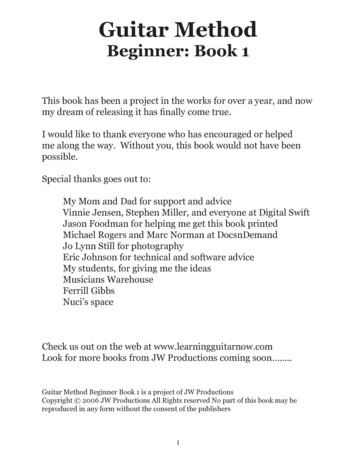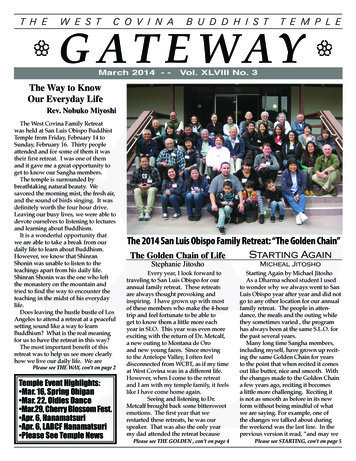
Transcription
Guitar Virtuosity for theEveryday ManFor use with Guitar Freak WorkstationSean Clancy2nd Edition 2009 Sean Clancy Enterprises
Guitar Virtuosity for the Everyday ManContents:Welcome to Guitar Freak Workstation with SightReader Master Extreme!3Foundation course12Lesson 1 -for beginners -the very basicsLesson 2 -the guitarLesson 3 -Naturalization -the conceptLesson 1 -TimingLesson 2 -strummingLesson 3 -strumming continuedLesson 4 - Alternate Picking made easyLesson 5 - The major scale -playing it in timing subdivisionsLesson 6 -Basic ChordsLesson 7 -Learning a basic songLesson 8 -How chords and scales work (also a little on GFW Quick chords)Chord Families -Introducing the Major, Minor and Dominant Families4610131921242729323438Rhythm – chords level 1 (learning rock level chords, top 40 level, pop, country, blues)40Lesson 1 -Barre chordsLesson 2 -Learning the notes on the E and A Strings (using GFW SightReader)Lesson 3 -Learning songs by EarLesson 4 -Finger PickingLesson 5 -Writing songs -song formsLesson 6 -Blues Structures and RhythmsLesson 7 -Working out chords for songs we may have heard but are in demand at anImpromptu jamLesson 8 -A list of popular songs to learn and steal forms from414548535659Lead – level 1, (getting to learn lead playing, playing over songs, sounding great69Lesson 1 -Finger agility!Lesson 2 -Laying chord shapes for your soloingLesson 3 -The Pentatonic Scale -part A Lesson 4 -Part B Lesson 5 -Breaking out of the box shapes Lesson 6 - Modes? I don’t need any stinking modes?Lesson 7 -Rules for Soloing1636770737780838790
Advanced Rhythm-Guitar Virtuosity for the Everyday ManLesson 1 -Stylistic RhythmsLesson 2 -Jazz ChordsLesson 3 -The Metronome “Practice Chords, Scales and LicksLesson 4 -Know where the 3, 5, 7 and root are.Lesson 5 -Changing to make any other chordLesson 6 -About jazz progressionsLesson 7 -II -V-I-VI all over the neckLesson 8 -Playing TechniquesLesson 9 -Reading charts939499101103105108112113116Advanced Lead121Jazz Improvisation: 15 Tips for Getting StartedLearning a Jazz TuneLead note experiment with ChordsIsolation exerciseJazz Standards to Learn and put your awesome licks into!List of Jazz Standards166168169170171172182183184185Lesson 1 -Speed and How to get itLesson 2 -Exercises to improve speed and Learn LicksLesson 3 -TechniquesLesson 4 -SequencesLesson 5 – Practice DiaryLesson 6 – Advanced TimingLesson 7 -Cool Licks and how to make licksLesson 8 -Elements of the Jazz LanguageLesson 9 -Playing notes in the chord (moving into jazz and fusion)Ear-training and Perfect PitchTransitioning from the Practice room to the gigFinal NotesTablature Guide2122124125134140142146149161
Guitar Virtuosity for the Everyday ManWelcome to Guitar FreakWorkstation with SightReaderMaster Extreme!This is a complete Lesson plan to get you to a professional sounding level as a guitarist.Bass players can also use these lessons and get great use out of them.These Lessons are the same that I use with my students and they get quite good results in the leastamount of time possible.I’m going to set a few goals (in my individual lessons, I customize the goals for each player – but as that’snot possible here, I’m going to have to blanket the goals with the most commonly requested)GoalsTo understand timing – the arch nemesis of guitarists the world over.To have a working knowledge of chords, scales, and how they apply to the guitar and to music in general To know the little tricks that make you sound like a pro instantly To be able to play lead, rhythm, compose. To learn to Sight-ReadOf course, we’ll be using Guitar Freak Workstation with SightReader Master Extreme (from now on I’llrefer to it as GFW) to achieve these goalsI’m going to assume that you’re a total beginner on guitar – so you intermediate or advanced players,feel free to browse the initial lessons and pick up where you feel you want to start working.So, the lessons will be set out like this:123456Beginning guitarThe foundation course (for all guitarists and bass players)Rhythm – chords level 1 (learning rock level chords, top 40 level, pop, country)Lead – level 1, (getting to learn lead playing, playing over songs, sounding great)Rhythm – chords level 2 (Jazz voicings, composition, comping, standards)Lead – level 2, (speed, jazz scales, advanced techniques, playing over changes)stLet’s begin – the 1 chapter is for beginners3
Guitar Virtuosity for the Everyday ManLesson 1Welcome future guitar and bass players! My name is Sean Clancy, creator of Guitar Freak Workstationwith SightReader Master Extreme. You may have bought your first guitar or bass and are wonderingwhere to begin You may have been:Trawling the net, checking at your local music shop or looking in the newspaper for lessons – well, if youwork through the lessons in this e-book, you may save yourself a truckload of cash!Of course, it’s good to use a teacher – but it’s sometimes difficult to find a teacher who can not onlyteach well – but also play well.I wouldn’t pay for anything less – and I find that the students I teach enjoy their lessons and come tolook forward to them!First things first Tuning your guitarOpen GFW and you’ll get this page:First of all, Make sure that Normal tuning is clicked – if you click “Down tuned ½ a step”, all the playingfunctions will sound one fret lower than normal tuning. A number of players used this tuning however,they included Jimi Hendrix, Eddie Van Halen, Yngwie Malmsteen and a number of modern bands as well– Alter bridge and Daughtry.But let’s stick to Normal Tuning for now.4
Guitar Virtuosity for the Everyday ManOpen up the Tuner (click on the 4 button, 2nd column from the left) you’ll get this window here. Thetuning pegs are the things you wind on your guitar to tune-up. Move your mouse and click on the tuningpegs of your instrument to hear the pitch you should tune your strings up to match.The guitar is the left hand headstock (that is the part of the guitar you can see here). The tuning foreach of these instruments is thisGuitarth Low – E string (lowest tuning peg on the left) – called the 6 string A string (middle peg on left) – called the 5 string D string (top peg on left) – called the 4 stringrdG string (top peg on right) – called the 3 string B string (middle peg on right) – called the 2 string High E-string (lowest tuning peg on right) – called the 1 string.ththndstBass 4 string (from the bottom peg to the top – all 1 octave lower than the guitar) E stringA stringD stringG stringBass 5 string has a low B – string for extra depth. The 6 string bass has a high C string – this is a morespecialized bass for soloing – I personally have not heard a 6 string bass that sounds as good as a 4 or 5string bass. My personal favorite bass sound is that of a fender jazz bass – a really nice woody sound.All the strings on the bass guitars tuned in 4ths (you’ll understand this when you learn about spelling).rdThe guitar is also tuned in 4ths except the G and B string which are tuned a Major 3 apart.5
Guitar Virtuosity for the Everyday ManLesson 2Now, we’re going to learn the parts of the guitar and how to hold it.The big part on the left is the body. The neck is the long thin part and that ends in the head stock (wherethe tuning pegs are)On the bodyWhere the strings start, that is called the bridge.The metal rectangle shapes are called pickups. This essentially house magnets that send out anelectrical field that pickup the sound of the vibrating strings and that sends a very small electricalcurrent to the controls on the guitar. The pickup to the left is called the Bridge pickup (which gives acrisp bright sound with lots of treble) and the pickup to the right is called the neck pickup (which gives awarm smooth sound). There is often a middle pickup between the two.There is always a pickup selector which gives you the option of choosing which pickup to choose from.The black knobs here are to control the volume of the 2 pickups and the tone of the 2 pickups. Just likeyour stereo at home. The tone controls (I believe) should be on full (at 10) if possible. They actuallysend out less signal if you have them turned down.On the neckThe thin metal rungs are called frets. When you place your fingers on the string between these, thestring makes contact with the metal on the left and when you pluck the string with your right hand, thestring makes contact with metal on the left and when you pluck the string with your right hand, thestring will vibrate from the metal point to the bridge. That’s why it’s better to place your finger closeto the fret to get better sustain with less effort (like this picture)6
Guitar Virtuosity for the Everyday ManOn the neck there are shapes between the frets. These are called fret markers and they help youlocate yourself on the neck.On the Head stockThe metal bolts that turn when you turn the tuning pegs are called machine heads. The brand andmodel of guitar are also displayed on the head stock. On the back of the neck, you may also get theserial number and year of the guitar.On this guitar, there is a metal bar attached to the bridge. This is called a whammy bar and pushing itto the body (when the bar is facing the neck) will slacken the strings causing them to drop in tuning.Facing the other way will tighten the string and raise the tuning. It can be used for a nice vibrato effectfor single notes or chords – or crazy sound effects like dive bombs (Listen to Eddie Van Halen forexamples)You might notice the pickups here. The bridge pickup looks like two pickups stuck together. Well, that’swhat they are. It’s called a hum-bucker pickup. The two pickups cancel out hum – and produce asmoother, louder tone. The pickups in the middle and neck are single coils – which have a tendency tohum (all though newer models are quieter). They also pick up more subtle nuances in the string (morepersonality). A pickup that has all the nuances of a single coil and the high gain and smoothness of thehumbuckers is a stacked humbucker such as the HS-3 pickup from dimarzio. I personally useLangcaster pickups as they have no hum and are high fidelity – great gain and shimmering highs andseismic lows. You can check them out at http://www.langcaster.com7
Guitar Virtuosity for the Everyday ManHow to hold the guitar (standing up and sitting down)8
Guitar Virtuosity for the Everyday ManWhat else will you need? A Pick. I recommend Jim Dunlop Jazz III picks. These are really hard picks and can be used forevery situation.A practice Diary (basically a school book) – check out the section on this on Page 140RulerPensGuitar Freak Workstation with SightReader Master Extreme (if you don’t have this already youcan download it from www.prolevelguitar.com)Also, the free style lessons available from my site.They are PDF’s based on simple guitar, blues, rock, band, shred, fusion and jazz. They’re realistic 45minute lesson plans which take you to different parts of the book which are relevant to you for the styleyou are interested in. They make use of this book and Guitar Freak Workstation to get you really good,as fast as possible, without too much overwhelming information.9
Guitar Virtuosity for the Everyday ManLesson 3Concept – Naturalization:Naturalization is the training of our muscle memory. Muscle memory is more sophisticated than wecan possibly imagine!Playing the guitar is an unnatural ability. But then, so was walking at one stage. That's what babiesare thinking as they have a go at it. However, they see everybody else doing it (which is why you needa good guitar teacher who can really play) and eventually, they start getting walking down. Now, asyou're older, I'd like to think you don't walk down to the shops thinking about which leg goes where!Our muscles only learn through repetition.After a while they'll get the idea and then do everything without much effort on your part – they'll takecare of all the details, you'll just think in terms of start, stop, when etc. Instead of thinking in bricks,you'll start thinking in buildings.Now, when you begin to learn something, make sure you do it right. Your muscle memory doesn'tknow what you're about to make it do – even if your head does. Unfortunately, if you make mistakes,your muscle memory thinks that's part of the program!So, when you're learning something – start off slow. Slow enough so that you can so it perfectly. Ifyou forget what comes next, freeze. Look at your reference to remember what comes next – and thenresume. Avoid extraneous movements. Guide your fingers as if you were guiding somebody whowas visually impaired (e.g. 'OK, we're coming to a curb', 'here's a step', etc)10
Guitar Virtuosity for the Everyday ManUsually, if we doing something perfect about 5 times, our muscle memory starts getting the picture.So, by working like this, you'll actually learn techniques and abilities faster than if you just rush in like abull in a china shop.And the most important:Make whatever you play sound cool! If it doesn’t sound pretty and great to you – chances are itwon’t to anybody else either. Work hard to make everything you play sound great – make yourselfhappy with your playing and you’ll have great fun and a great future!How to hold the pickThese diagrams should help you to understand how to hold the pick.11
Guitar Virtuosity for the Everyday ManNow, we're ready to move on. Onto the foundation courseFoundation Course1.2.3.4.5.6.7.Timing – be able to navigate timing subdivisions – be able to get a tempo from a 4/4 drum beatStrumming – being able to strum evenly. Able to write down patterns in music form.Picking exercise – even alternate picking made easy!Major scale – learn the Ionian (major) scale in CBe able to apply the timing to the Ionian scale.Learn some basic chords.How chords and scales work!Now this foundation course is harder than it looks (I'm referring to you intermediate and advancedguitarists) – I would suggest you be able to do these things – I
Guitar Virtuosity for the Everyday Man 2 Advanced Rhythm- 93 Lesson 1 -Stylistic Rhythms 94 . Lesson 2 -Jazz Chords 99 . Lesson 3 -The Metronome “Practice Chords, Scales and Licks 101 . Lesson 4 -Know where the 3, 5, 7 and root are. 103











